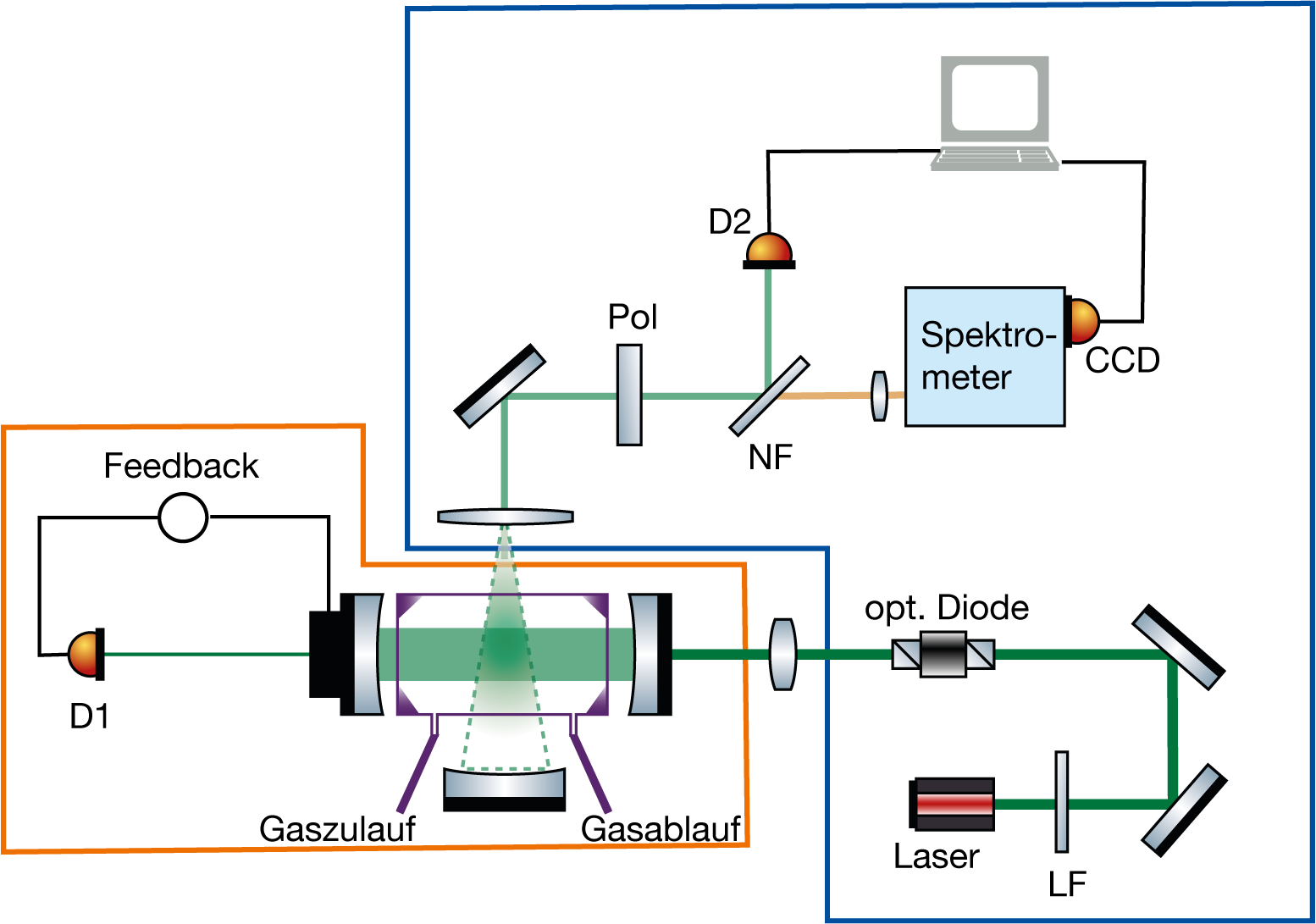
Method and apparatus for identifying volatile substances with resonator-enhanced Raman spectroscopy at reduced pressure
The method presented here provides a universal, selective, fast and efficient method for the identification of gaseous molecules based on cavity-enhanced Raman spectroscopy (CERS) at reduced pressure.
Challenge
In various fields such as research, technology, environment and medicine, it is essential to determine the composition of gases very precisely. Gas analyses are used in a variety of ways. Starting with the determination of the purity of a gas up to the examination of emitted pollutants over applications in research and medicine, in which the composition of the gas mixture (e.g. breathing air) is analyzed, in order to make conclusions on certain clinical pictures. Many of these applications must be carried out efficiently and, above all, quickly (instantaneously). The current state of technology offers a variety of procedures and methods to accomplish such tasks. However, these methods are often costly and time-consuming. Another disadvantage of many methods is the local binding, e.g. to a laboratory, so that samples have to be taken and transported to the place of analysis. Furthermore, measurements of low-volatile substances under normal pressures often result in deposits on the walls of the measuring cells, which subsequently leads to contamination of subsequent measurements. In addition, most of the available analytical methods are specialized in one aggregate state. They can examine only gaseous or only liquid samples.
Our solution
The proposed method is a combination of a CERS detector and a gas chromatograph (GC). The CERS detector consists of three modules; the Raman setup, the resonator and the gas cell or GC (Figure 1); with a negative pressure in the sensing cell. By creating a negative pressure, low volatile substances are prevented from remaining in the sensing cell, contaminating and distorting subsequent gas analyses. In addition, the use of negative pressure allows the analysis of substances that are volatile at room temperature. The CERS detector operates with gas flows of 1 to 10 ml/min. This allows small measurement intervals of one to three seconds. The method can therefore be used wherever the measurement time for identifying a gas sample is limited. The combination with a GC column allows the admixture of different gases. At the same time, the composition of complex gas mixtures can be determined without the need to increase the resolution of the Raman spectrometer. Alternatively, the method can also be used to investigate substances in their liquid aggregate state. The detection and resolution limits are determined with defined test gases. A controllable laser resonator maximizes Raman excitation and guarantees the achievement of low detection limits. The coupling of the CERS detector with the GC in a compound represents a solution that can be implemented very easily in a mobile setup.
 Fig. 1: Schematic setup of the CERS experiment. The blue module represents the setup of the Raman spectrometer with the possibility to measure polarization dependent. (NF: notch filter, LF: laser line filter, pole: polarization unit, D2: diode). The orange module contains the resonator setup. Here the irradiated light is amplified. The output coupler mirror sits on a piezo element and can be controlled to maximum intensity by means of a feedback loop (D1: diode). The last module is the gas cell, which can be heated and whose input is connected to the gas chromatography.
Fig. 1: Schematic setup of the CERS experiment. The blue module represents the setup of the Raman spectrometer with the possibility to measure polarization dependent. (NF: notch filter, LF: laser line filter, pole: polarization unit, D2: diode). The orange module contains the resonator setup. Here the irradiated light is amplified. The output coupler mirror sits on a piezo element and can be controlled to maximum intensity by means of a feedback loop (D1: diode). The last module is the gas cell, which can be heated and whose input is connected to the gas chromatography.
Advantages
- Can be implemented as a mobile measuring device
- Analysis of gases that are volatile at room temperature
- Allows gas analysis at short measurement intervals
- Minimized measuring cell contamination
- Also analysis of liquids possible
Applications
- Environmental technology (pollutant analysis)
- Verification of purity of process gases in industry (semiconductor manufacturing)
- Medical technology (analysis of breathing air and detection of disease patterns)
- Safety engineering
- In research (laboratory use)
Development status
The process is currently under construction.
Patent status
German patent application: DE102019104481A1 (published)
International patent application: WO2020169808A1 (published)
Patent holder: Institut für Nanophotonik Göttingen e.V.
Contact
Dr. Maria Kamper
Patent Manager Physics & Technology
E-Mail: This email address is being protected from spambots. You need JavaScript enabled to view it.
Tel.: +49 551 30724 159
Reference: CPA-2119-LLG
